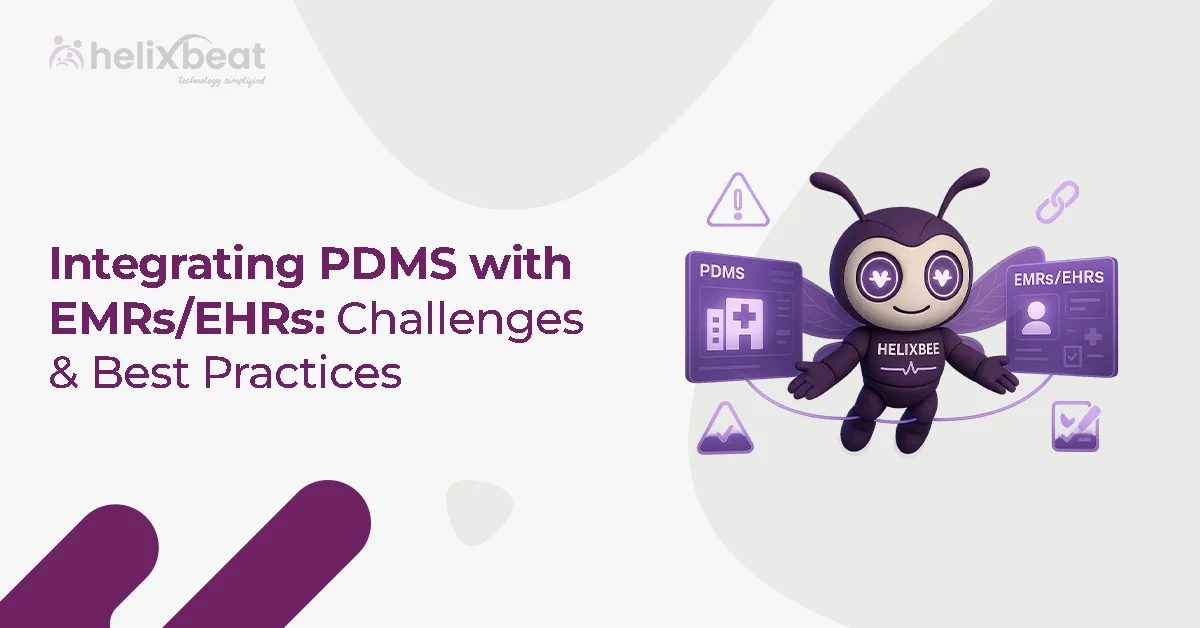Table of Contents
Introduction
Did you know that 67% of all clicks go to the first five organic results on a search engine?
This statistic highlights just how important it is to secure those top-ranking positions with the right SEO strategy creation in place.
But here’s the challenge- are you sure your SEO investment is delivering the results you’re aiming for?
Thankfully, there’s a solution: Google Analytics.
This free and powerful tool offers a treasure trove of insights to help you measure the success of your SEO marketing strategy. When used effectively, it can provide actionable data to refine your strategies and ensure you stay ahead of the competition.
In this blog, we’ll dive into some of the best Google Analytics tips to help you improve your SEO strategy creation and maximize your website’s potential.
What is Google Analytics in SEO marketing strategy?
Imagine you’re the captain of a ship navigating through uncharted waters. To reach your destination, you need tools to monitor the ocean, track your course, and make adjustments along the way. In the digital world, Google Analytics is that essential tool for website owners and marketers.
Google Analytics is like your website’s control center—a web analytics tool that gives you advanced statistics and insights about your website’s performance and visitors. It’s not just a nice-to-have; it’s a must-have in any marketer’s SEO toolkit.
Think about it: when visitors land on your website, they leave behind a trail of data—how they found your site, what pages they visited, how long they stayed, and even what made them leave. Google Analytics collects all this information and organizes it into actionable insights that can shape your SEO strategy creation and SEO marketing strategy.
But Google Analytics doesn’t work in isolation. Just like a great captain uses multiple instruments to steer their ship, SEO strategy creation combine Google Analytics with other tools to dig deeper. In fact, most SEOs use at least two additional tools alongside Google Analytics to measure performance, uncover trends, and optimize results.
So, ask yourself: How many tools are you using to improve your SEO marketing strategy?
How Does Google Analytics Help Improve SEO Strategy Creation?
Let’s break it down with an analogy. Think of your website as a restaurant. Google Analytics is like having a super-smart manager who knows exactly what’s working and what’s not.
For instance, this manager (Google Analytics) can tell you:
- Which dishes (web pages) your customers love.
- How they discovered your restaurant (traffic sources).
- How long they stayed and if they left satisfied (bounce rates and session duration).
- Whether your marketing flyers (ads or campaigns) brought in new diners.
Here’s where Google Analytics truly shines: it’s a product of Google, the search engine most of your visitors used to find your site. This gives it unique insights that other tools can’t match. With GA, you can:
- Track your website’s performance.
- Understand your visitors’ behavior.
- Measure the success of your campaigns.
- Monitor goal completions.
- Spot patterns in engagement and optimize accordingly.
- Analyze demographic and geographic data about your audience.
For example, let’s say you notice a high bounce rate on one of your top-performing pages. This could mean the content isn’t engaging enough or doesn’t match the search intent. With this insight, you can tweak the content to make it more relevant, ultimately improving your rankings.
Or consider this: your GA dashboard shows that your audience mostly comes from a specific region. This might prompt you to tailor your marketing campaigns to better connect with that demographic.
Pro Insight: Anastasia Kotsiubynska from SE Ranking puts it best:
“Google Analytics helps you understand all your organic traffic data—like which search engines bring in visitors, which landing pages perform best, and how people behave on your website. With GA4, SEOs can identify content that isn’t engaging enough (e.g., pages with low time-on-page or high bounce rates) and make necessary changes to align with search intent.”
Top 10 Google Analytics Tips to Improve Your SEO Marketing Strategy:
1. Track Organic Traffic Trends
Your organic traffic plays a pivotal role in measuring the success of your SEO strategy creation. To track this metric in Google Analytics:
Navigate to Acquisition > All Traffic > Channels. Here, you’ll be able to filter traffic by organic search.
Observe trends over time to evaluate whether your organic traffic is growing, steady, or declining.
Tip: Create custom reports focused on specific landing pages or traffic sources to gain deeper insights into what contributes most to your organic traffic.
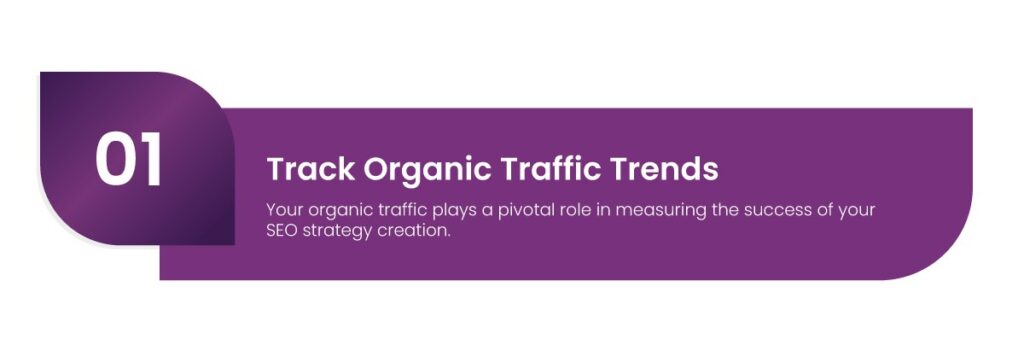
2. Analyze Top Landing Pages
Top landing pages reflect the content and keywords that resonate with your audience. Here’s how to analyze them:
Go to Behavior > Site Content > Landing Pages to view your site’s landing page performance.
Filter by organic traffic to isolate pages that are receiving the most visits from search engines.
Action Point: Take note of high-performing pages and consider optimizing them by adding more relevant keywords or improving content to attract additional visitors.
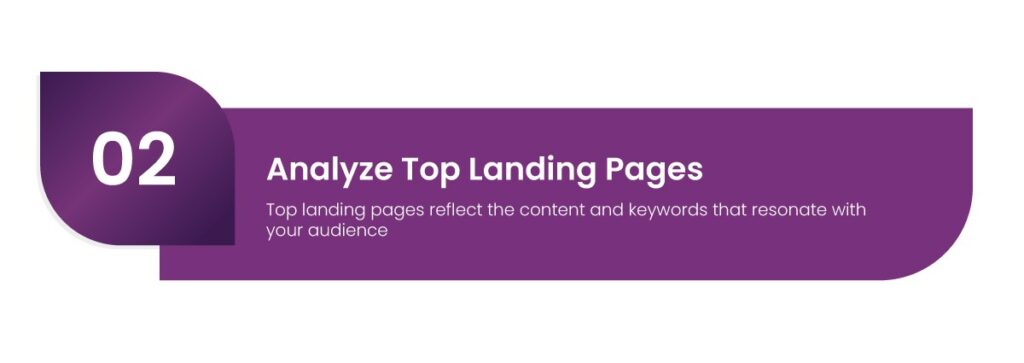
3. Study User Behavior with Behavior Flow
The Behavior Flow report shows how users move through your website, highlighting patterns and potential issues.
Navigate to Behavior > Behavior Flow to see the paths users take from one page to another.
Pay attention to areas where users tend to drop off or exit the site. This can indicate where improvements are needed.
SEO Tip: Use insights from the Behavior Flow report to adjust your website’s layout or navigation, ultimately reducing bounce rates and keeping visitors engaged for longer.
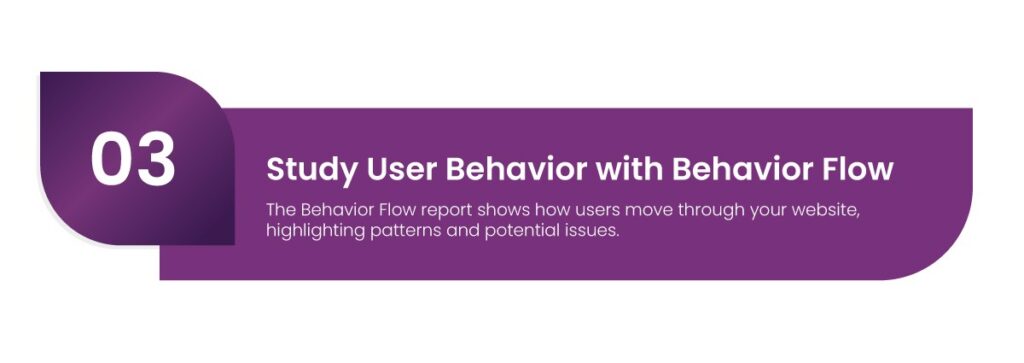
4. Monitor Bounce Rates and Time on Page
Bounce rate and average time on page are key metrics that directly influence your site’s SEO ranking.
To review these metrics, go to Behavior > Site Content > All Pages.
Sort pages by bounce rate or average time spent on each page to understand how well your content engages users.
SEO Strategy Creation: For pages with a high bounce rate, consider revising the content. Adding engaging visuals, clearer calls to action (CTAs), and better readability can keep users on your site longer.
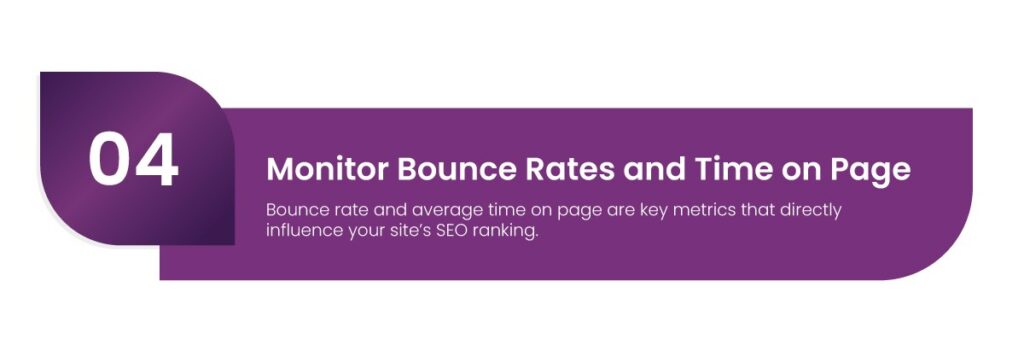
5. Set Up Goals to Track Conversions
An important aspect of any SEO strategy creation is converting traffic into tangible results. Use Goals in Google Analytics to measure the impact of your SEO efforts:
Go to Admin > Goals > New Goal to set up conversions such as form submissions, product purchases, or content downloads.
Once your goals are set, associate them with specific landing pages or campaigns to get detailed performance data.
Pro Tip: By tracking conversions, you can better understand which traffic sources, pages, or keywords are driving meaningful actions on your website.
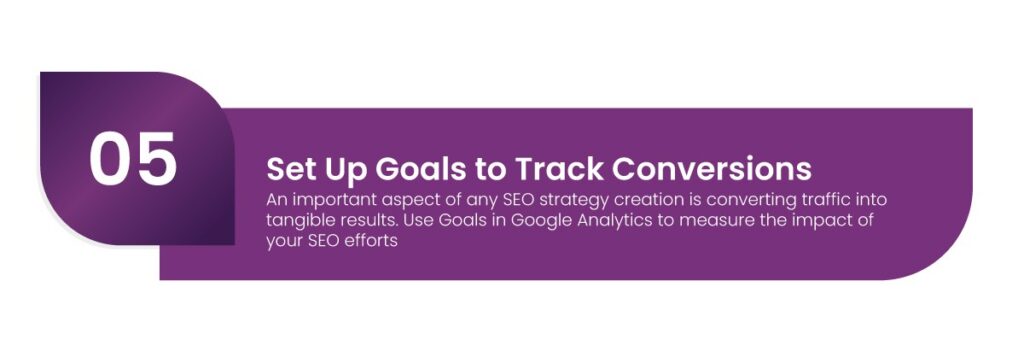
6. Use Site Search Analytics
The site search feature in Google Analytics provides valuable insights into what users are looking for on your website.
Go to Behavior > Site Search > Search Terms to view the search queries entered by visitors.
Review the most common or popular search terms to identify any gaps in your content or areas where users may not be finding what they need.
Action Plan: Use this data to create new content or optimize existing pages that target these search terms, helping you meet user needs and improving SEO performance.
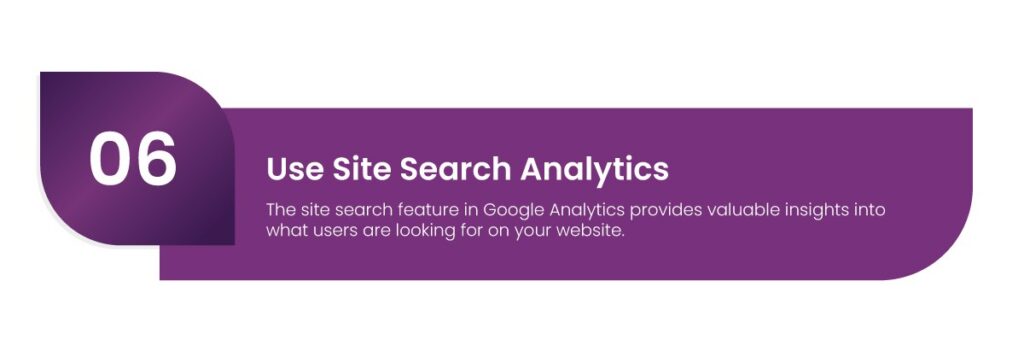
7. Leverage Audience Demographics
Understanding the demographics of your site visitors is essential for refining your SEO strategy Creation. Google Analytics offers detailed data on factors such as age, gender, location, and interests.
Find this information under Audience > Demographics.
By reviewing your audience’s profile, you can tailor your content, blog posts, and SEO strategy creation to better align with the needs and interests of your primary audience.
SEO Advantage: If you discover that a certain geographic region or age group is more engaged with your content, you can create targeted content that speaks directly to those demographics.
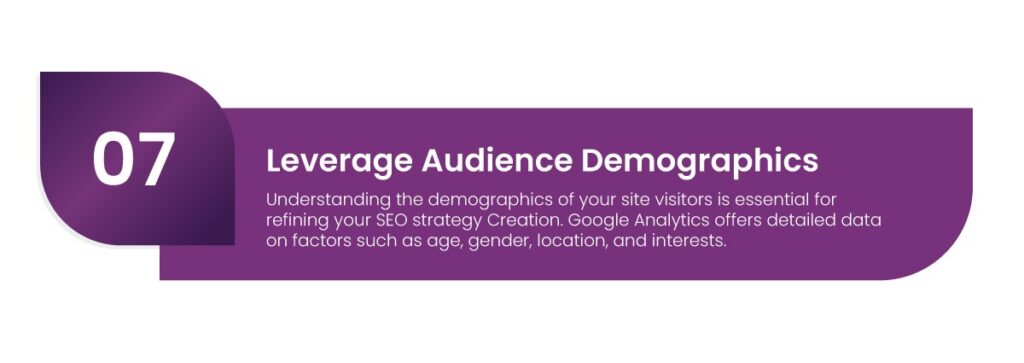
8. Measure Mobile Performance
With the majority of searches now happening on mobile devices, your site’s mobile performance is a major factor in your SEO strategy creation.
Navigate to Audience > Mobile > Overview to compare the traffic, bounce rate, and engagement metrics for mobile users versus desktop users.
By monitoring these metrics, you can identify any mobile-specific issues that might be affecting the user experience.
Fixes: Address mobile-specific concerns by improving load times, optimizing page design for smaller screens, and ensuring that CTAs are easy to tap for mobile users.
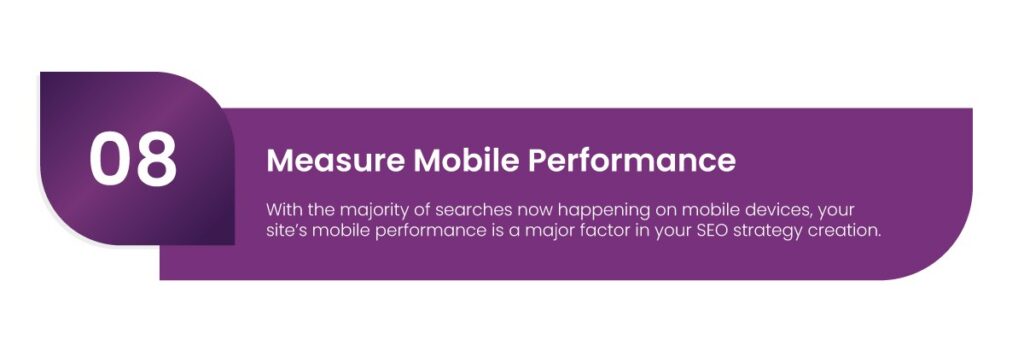
9. Check Referral Traffic for Backlink Insights
Backlinks are an important ranking factor in SEO strategy creation. Google Analytics provides data on the referral traffic from external websites that link to your pages.
Go to Acquisition > All Traffic > Referrals to see which sites are sending traffic to your website.
Identifying top referring sites can help you understand which backlinks are having the most impact on your traffic.
Pro Tip: Foster relationships with websites that send quality traffic your way, and explore opportunities to collaborate on additional link-building or content-sharing efforts.
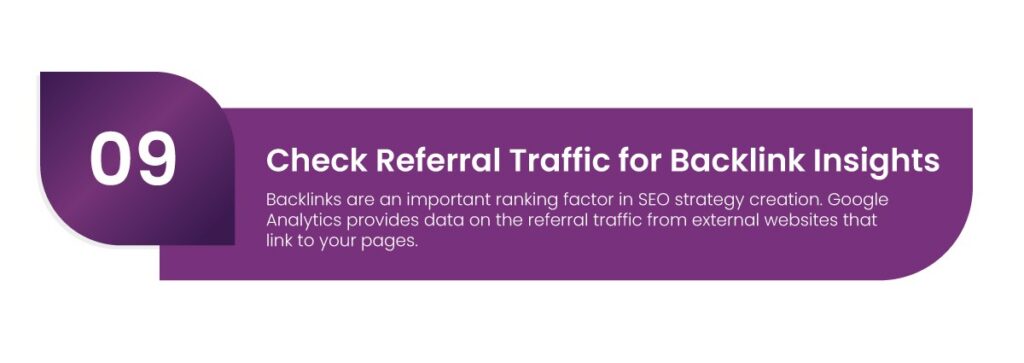
10. Integrate Google Search Console with Google Analytics
Integrating Google Search Console with Google Analytics allows you to view search-related data directly within your Analytics reports.
Link both accounts via Admin > Property Settings > Adjust Search Console.
Once connected, you can find valuable keyword data under Acquisition > Search Console > Queries.
SEO Move: Focus on improving rankings for keywords that have high impressions but low click-through rates (CTR). These are opportunities where you can optimize meta tags, content, or page layout to capture more traffic.
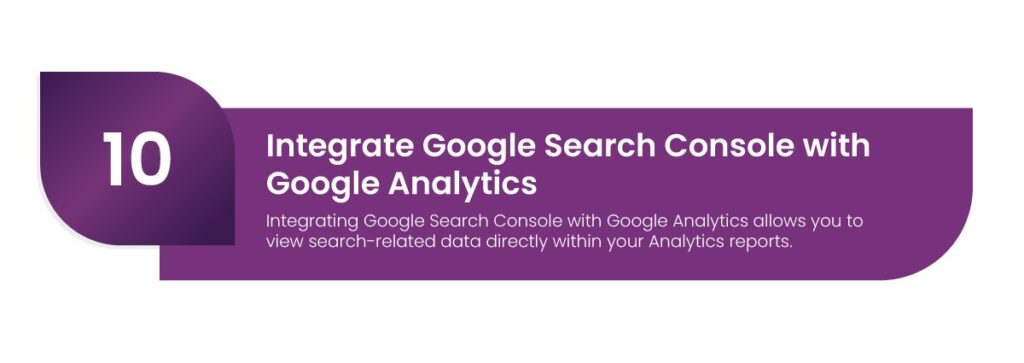
Wrapping Up
When it comes to improving your SEO strategy creation, Google Analytics is one of the most powerful tools at your disposal. By tracking key metrics like organic traffic, bounce rates, and time on page, you gain a clearer picture of how your site is performing and where improvements are needed.
Analyzing your top landing pages, user behavior, and site search data can help you make better decisions about your content and design. Setting up goals and understanding your audience demographics can help turn traffic into conversions.
That’s where Helixbet comes in. A team of global SEO experts they know exactly how to use tools like Google Analytics to get your website to rank higher and perform better. They provide a range of digital marketing services tailored to your needs, whether you’re promoting a product, service, or platform.
With Helixbet’s support, you’re not just optimizing your site for search engines—you’re creating an SEO marketing strategy that connects with your audience and drives real results.
Frequently Asked Question
- What is Google Analytics, and how does it help with SEO?
Google Analytics is a web analytics tool that provides insights into your website’s traffic, user behavior, and performance. It helps SEO by tracking organic traffic, measuring user engagement, identifying top-performing pages, and pinpointing areas for optimization.
- How can I track organic traffic in Google Analytics?
To track organic traffic, navigate to Acquisition > All Traffic > Channels in Google Analytics. Here, you can filter traffic by organic search and monitor trends over time to evaluate your SEO performance.
- What is the Behavior Flow report in Google Analytics, and how can it improve SEO?
The Behavior Flow report shows the paths users take through your website. By analyzing this flow, you can identify drop-off points or areas where users lose interest, helping you optimize your website’s layout and content for better engagement.
- How can I improve my bounce rate using Google Analytics?
Review the bounce rates of individual pages under Behavior > Site Content > All Pages. Pages with high bounce rates may need better content, more engaging visuals, or clearer calls-to-action (CTAs) to keep visitors engaged longer.
- What are Goals in Google Analytics and how do they relate to SEO?
Goals in Google Analytics allow you to track specific user actions, such as form submissions or purchases. Setting up goals helps measure the success of your SEO strategy by linking website traffic to meaningful conversions.
- How can I use site search data to improve my SEO?
The Site Search feature in Google Analytics shows what users search for on your website. By reviewing common search terms, you can identify content gaps and optimize pages to meet user needs and improve SEO.
- How do I track the performance of mobile users in Google Analytics?
Go to Audience > Mobile > Overview to see how mobile users perform on your site compared to desktop users. This helps identify mobile-specific issues and optimize the mobile user experience to improve SEO rankings.
- Can Google Analytics help me track my backlinks?
Yes, by navigating to Acquisition > All Traffic > Referrals, you can track referral traffic and identify which websites are sending traffic to your site. This helps you analyze the impact of backlinks on your SEO performance.












